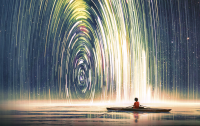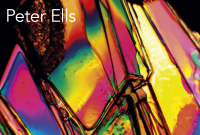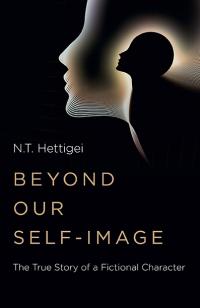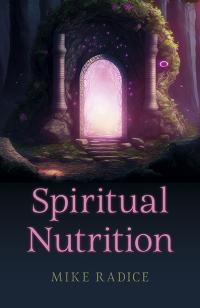
Extract
The calls of the absurd – with their simultaneous contradictoriness, symbolism, and physical reality – have led us to review some of the latest, groundbreaking results coming out of experimental physics. These results, among which one finds the experimental confirmation of quantum entanglement and the correlation between global mind states and physical events, have exposed the untenability of realism. As such, the world ‘out there’ is not independent of the thoughts ‘in here.’
In examining the implications of the defeat of realism, we have concluded that we must abandon logical bivalence as well; that is, the idea that things must be either true or false. Indeed, without realism there is no correspondence theory of truth to substantiate bivalence. Things can indeed be true and false, real and imaginary, so long as we construct them to be so. We have thus been led into intuitionistic logic and constructivism as, respectively, a coherent mode of thinking and a worldview that remained consistent with all the latest experimental results, as well as with the calls of the absurd. We discovered that reality is the outcome of a coherent mental construction, whose coherence constraints nonetheless do not leave much room for relativism. The historical review of the evolution of scientific thought, as done by Thomas Kuhn, seemed to confirm all this.
Upon the realization that subjective psyche and objective reality are likely two aspects of a single system, we delved into depth psychology in the hope of finding a less epiphenomenal map of reality than physics. We found it in the rich work of Carl Jung, who discovered the complexities and unfathomable depth of the unconscious layers of our minds. The implication was clear: next to our ordinary consensus meta-reality, we must all partake of other meta-realities, despite not being normally aware of them due to the perennial veil of amnesia. These other meta-realities are intrinsically paradoxical and mythopoetic. The calls of the absurd may be but protrusions of these normally unconscious meta-realities into the ordinary field of awareness. As such, they are both psychological and physical.
The insights acquired from these apparently incommensurable threads of investigation came together in a surprisingly consistent manner: the constructivism apparent in the historical observations of Kuhn can be explained by the defeat of realism coming out of physics laboratories; Jung’s empirical observations of the contradictoriness of the unconscious are consistent with the lack of bivalence underlying the intuitionistic logic we found to be governing reality; the metaphorical language of the unconscious, as expressed in the world’s fairy tales, finds uncanny correspondence with the symbolical character of the calls of the absurd. Indeed, the empirical insights of depth psychology regarding the absurd nature of the unconscious seem to independently confirm the conclusions we derived from physics and analytic philosophy regarding the nature of reality. The consistency and mutual confirmation across all these independent threads is intriguing.
So we are now left with a worldview where logic is itself a construction of the mind, not a strongly-objective truth lying in a platonic realm. Rationality is a thin, limited crust around an unfathomable core of the unformed; the meaningful irrational; the realm of the imagination. Yet the word ‘irrational’ must be read with care: here it does not denote foolishness – that is, the lazy neglect of logic – but the very transcendence of the limits of logic. The irrationality of our worldview exceeds and goes beyond logic.
We all instinctively look for solid references to ground our thoughts, judgments, and decisions. We need neutral and reliable foundations to build our lives on. Some of us find these foundations in ethics and morals; others, in science and rationality; yet others, in religion or mythology. Still, we all seem to, implicitly as it may be, rely on logic as the ultimate glue holding these various foundations together. Hence, when acknowledging that logic is itself a construct of our imagination – a self-created set of limits – we may feel as though the rug were pulled from under our feet. What references are we then left with to tell meaning from foolishness? Will we be condemned to live out our lives in disorder and meaninglessness? What grounds can we find to guide our future views and choices?
That may be the greatest challenge lying in wait in our future. Indeed, it may be the most formidable challenge humanity has yet confronted. And, like many great challenges, it may also represent the greatest opportunity we have ever had to shape our own existence: an opportunity to remold the very fabric of reality and truth.
Plato identified truth with beauty. For him, the true was indeed the beautiful. So here may lie an important clue: if the desacralization of logic pulls the rug of truth from under our feet, we still have beauty to guide our way. Aesthetics transcends logic; it comes from deep within the bowels of the mountain chain. The foundations of our future may be aesthetical: that which inspires and feeds the soul; that which is conducive to happiness and harmony. The basis of our collective judgment as a culture may need to be transmuted from logic to that which guides the hand of an artist. And this does not need to be so difficult: deep inside, we all have an innate, intuitive notion of what is harmonious, beautiful, and fulfilling; if only we can give this innate impulse unfiltered and unbiased expression.
There is no denying that the path to the transcendence of logic can be an arduous one. Multiple deadly mines may lie buried on its roads: relativism, disorder, foolishness, paranoia, and insecurity, to name only a few. Yet, traversing it could also be a fulfilling and fun journey: Have you ever noticed how the amusing element of puns is their ambiguity and double meaning? Puns defy bivalence and literal interpretations, this being the very reason why they are funny. They show beyond doubt that ambiguity is inherently fun, light-hearted, and pleasing. The transcendence of bivalence can be a reason for fun and laughter at least as much as it can be a reason for distress. Ultimately, it may all depend on the inner attitudes we bring to the process.
The death of bivalence comes hand in hand with the death of its twin brother, realism. As we traverse the cosmological individuation path towards the absurd – not the meaningless – we will find ourselves in a reality of mind; in the realm of the imagination. Some surprises may lie on our way: Who is to say that the islands of ego-consciousness representing terrestrial life are not just a local archipelago among many others? How can we be sure that, connected to the same submerged mountain chain but located way over the horizon, there are not countless other peaks forming countless other archipelagos? If so, then these other archipelagos may have their own collective, weakly-objective, consensus meta-realities, entirely different from ours. Indeed, this would give an intriguing new twist to the scientific idea of parallel universes and other dimensions, as well as to the religious idea of inhabited spiritual realms. Moreover, since all these archipelagos are but saliencies of the very same mountain chain of mind, we may all be, deep inside, intrinsically connected to those other consensus meta-realities; just not ‘tuned’ into them ordinarily. As we progress towards cosmological individuation, confronting more and more of the contents of our unconscious minds, it may sometimes not be trivial to distinguish between private meta-realities and occasional access to these other, hypothetical consensus meta-realities from over the horizon. Will we be able to tell a personal reverie from an accidental tuning into alternative meta-realities created and inhabited by beings whose existence currently lies beyond our knowledge?
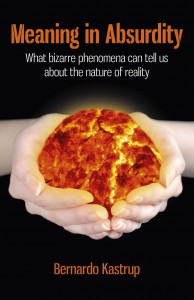 This book is an experiment. Inspired by the bizarre and
uncanny, it is an attempt to use logic to expose the illogical foundations of logic; an attempt to use science to peek beyond the limits of science; an attempt to use rationality to lift the veil off
the irrational. Its ways are unconventional: weaving along its path one finds UFOs and fairies, quantum mechanics, analytic philosophy, history, mathematics, and depth psychology. The enterprise of
constructing a coherent story out of these incommensurable disciplines is exploratory. But if the experiment works, at the end all these disparate threads will come together to unveil a
startling scenario about the nature of reality and our condition within it. The payoff is handsome: a reason for hope, a boost for the imagination, and the promise of a meaningful future. But it does
not come for free: this book may confront some of your dearest notions about truth and reason. Yet, one cannot dismiss its conclusions lightly, because
the evidence it compiles and the philosophy it leverages are solid in the orthodox, academic sense.
This book is an experiment. Inspired by the bizarre and
uncanny, it is an attempt to use logic to expose the illogical foundations of logic; an attempt to use science to peek beyond the limits of science; an attempt to use rationality to lift the veil off
the irrational. Its ways are unconventional: weaving along its path one finds UFOs and fairies, quantum mechanics, analytic philosophy, history, mathematics, and depth psychology. The enterprise of
constructing a coherent story out of these incommensurable disciplines is exploratory. But if the experiment works, at the end all these disparate threads will come together to unveil a
startling scenario about the nature of reality and our condition within it. The payoff is handsome: a reason for hope, a boost for the imagination, and the promise of a meaningful future. But it does
not come for free: this book may confront some of your dearest notions about truth and reason. Yet, one cannot dismiss its conclusions lightly, because
the evidence it compiles and the philosophy it leverages are solid in the orthodox, academic sense.
BUY ONLINE
Categories:
0 comments on this article

